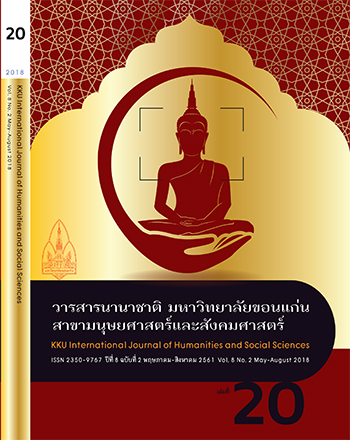Synthesis of Researches in Teaching Thai as a foreign Language
Main Article Content
Abstract
This study aimed to synthesize abstracts of studies related to teaching and learning Thai as a foreign language within the period between 1985 and 2015. The target population used in the research was 156 theses/ dissertations and independent studies at the level of master’s degree and doctoral degree. Purposive sampling technique was used in selecting theses/dissertations and independent studies from 14 universities including Srinakharinwirot University, Chulalongkorn University, Silpakorn University, Khon Kaen University, Chiang Mai University, Burapha University, Kasetsart University, Thaksin University, Thammasat University, Chiang Rai Rajabhat University, Rajamangala Thanyaburi University, Ramkhamhaeng University, Dhurakij Pundit University, and Rambhaibarni Rajabhat University. The research instrument was records which summarize the details of studies. The statistical analysis was in frequencies and percentage.
The study results revealed that there were 156 studies related to teaching and learning Thai as a foreign language between 2518 and 2558 and the most studied were concerned with technology and innovation in teaching and learning, at the number of 97 studies, which accounted for 62.17 per cent. 33 studies were concerned with behavioral studies of instructors and learners, accounting for 21.29 per cent. These were followed by 19 studies concerning teaching methodologies of Thai as a foreign language at 12.17 per cent, 4 regarding Thai curriculum studies at 2.56 per cent, and 3 in relation to instruction of Thai as a foreign language at 1.92. The topic which was studied least in the field was the analysis of learning materials of Thai as a foreign language, where only 2 studies were found, accounting for only 1.28 per cent. The studies of testing and assessment in the field of teaching and learning Thai as a foreign language were not found.
Based on the synthesis, it was found that studies concerning technology and innovation in teaching and learning Thai as a foreign language were experimental studies to investigate the efficiency of tools such as lessons, textbooks, manuals, reading materials, exercises, instructional package, all of which were related to language usage, grammar as well as Thai culture. All the tools in the studies were proved efficient. In terms of research related to behavioral studies of instructors and learners, it was found that instructors conducted a small amount of research, had moderate knowledge about the sound system and grammar, and had needs for curriculum development, instructional activities, teaching techniques, testing and assessment, as well as instructional media. Learners, on the other hand, had problems about listening, speaking, reading and writing skills and had needs for learning materials, exercises, activities and content in Thai language which can be used for work. There were only a few studies which were concerned with both instructors and learners. Problems and obstacles during the conversations between instructors and learners were also found. With regard to instruction of Thai as a foreign language, most studies compared Thai with the native language of learners where emerging issues consequently led to implications for lesson planning and recommendations. For curriculum studies of Thai as a foreign language, it was found that the curriculum could help to develop the language skills of foreign learners. In the aspect of studies concerning the analysis of learning materials of Thai as a foreign language, only a few studies were conducted; however, they could be used as guidelines in teaching and learning Thai as a foreign language. In relation to instruction of Thai as a foreign language, there were issues of undefined curriculum, small number of instructors, and easy content. Moreover, there were suggestions regarding culture in that it should be more applicable to real life. Activities, media, and length of study time should also be enhanced.


